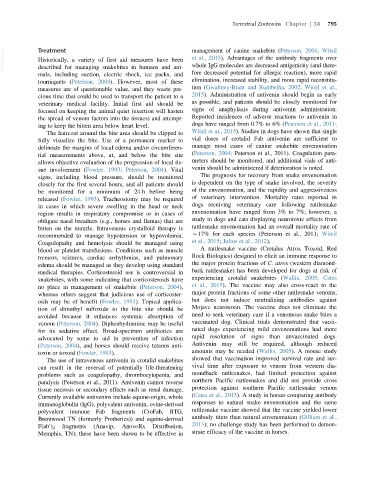Page 837 - Veterinary Toxicology, Basic and Clinical Principles, 3rd Edition
P. 837
Terrestrial Zootoxins Chapter | 58 795
VetBooks.ir Treatment management of canine snakebite (Peterson, 2004; Witsil
et al., 2015). Advantages of the antibody fragments over
Historically, a variety of first aid measures have been
whole IgG molecules are decreased antigenicity (and there-
described for managing snakebites in humans and ani-
mals, including suction, electric shock, ice packs, and fore decreased potential for allergic reaction), more rapid
tourniquets (Peterson, 2004). However, most of these elimination, increased stability, and more rapid reconstitu-
measures are of questionable value, and they waste pre- tion (Gwaltney-Brant and Rumbeiha, 2002; Witsil et al.,
cious time that could be used to transport the patient to a 2015). Administration of antivenin should begin as early
veterinary medical facility. Initial first aid should be as possible, and patients should be closely monitored for
focused on keeping the animal quiet (exertion will hasten signs of anaphylaxis during antivenin administration.
the spread of venom factors into the tissues) and attempt- Reported incidences of adverse reactions to antivenin in
ing to keep the bitten area below heart level. dogs have ranged from 0.7% to 6% (Peterson et al., 2011;
The haircoat around the bite area should be clipped to Witsil et al., 2015). Studies in dogs have shown that single
fully visualize the bite. Use of a permanent marker to vial doses of crotalid Fab antivenin are sufficient to
delineate the margins of local edema and/or circumferen- manage most cases of canine snakebite envenomation
tial measurements above, at, and below the bite site (Peterson, 2004; Peterson et al., 2011). Coagulation para-
allows objective evaluation of the progression of local tis- meters should be monitored, and additional vials of anti-
sue involvement (Fowler, 1993; Peterson, 2004). Vital venin should be administered if deterioration is noted.
signs, including blood pressure, should be monitored The prognosis for recovery from snake envenomation
closely for the first several hours, and all patients should is dependent on the type of snake involved, the severity
be monitored for a minimum of 24 h before being of the envenomation, and the rapidity and aggressiveness
released (Fowler, 1993). Tracheostomy may be required of veterinary intervention. Mortality rates reported in
in cases in which severe swelling in the head or neck dogs receiving veterinary care following rattlesnake
region results in respiratory compromise or in cases of envenomation have ranged from 3% to 7%; however, a
obligate nasal breathers (e.g., horses and llamas) that are study in dogs and cats displaying neurotoxic effects from
bitten on the muzzle. Intravenous crystalloid therapy is rattlesnake envenomation had an overall mortality rate of
recommended to manage hypotension or hypovolemia. B17% for each species (Peterson et al., 2011; Witsil
Coagulopathy and hemolysis should be managed using et al., 2015; Julius et al., 2012).
blood or platelet transfusions. Conditions such as muscle A rattlesnake vaccine (Crotalus Atrox Toxoid, Red
tremors, seizures, cardiac arrhythmias, and pulmonary Rock Biologics) designed to elicit an immune response to
the major protein fractions of C. atrox (western diamond-
edema should be managed as they develop using standard
medical therapies. Corticosteroid use is controversial in back rattlesnake) has been developed for dogs at risk of
snakebites, with some indicating that corticosteroids have experiencing crotalid snakebites (Wallis, 2005; Cates
no place in management of snakebite (Peterson, 2004), et al., 2015). The vaccine may also cross-react to the
whereas others suggest that judicious use of corticoster- major protein fractions of some other rattlesnake venoms,
oids may be of benefit (Fowler, 1993). Topical applica- but does not induce neutralizing antibodies against
tion of dimethyl sulfoxide to the bite site should be Mojave neurotoxin. The vaccine does not eliminate the
avoided because it enhances systemic absorption of need to seek veterinary care if a venomous snake bites a
venom (Peterson, 2004). Diphenhydramine may be useful vaccinated dog. Clinical trials demonstrated that vacci-
for its sedative effect. Broad-spectrum antibiotics are nated dogs experiencing mild envenomations had more
advocated by some to aid in prevention of infection rapid resolution of signs than unvaccinated dogs.
(Peterson, 2004), and horses should receive tetanus anti- Antivenin may still be required, although reduced
toxin or toxoid (Fowler, 1993). amounts may be needed (Wallis, 2005). A mouse study
The use of intravenous antivenin in crotalid snakebites showed that vaccination improved survival rate and sur-
can result in the reversal of potentially life-threatening vival time after exposure to venom from western dia-
problems such as coagulopathy, thrombocytopenia, and mondback rattlesnakes, had limited protection against
paralysis (Peterson et al., 2011). Antivenin cannot reverse northern Pacific rattlesnakes and did not provide cross
tissue necrosis or secondary effects such as renal damage. protection against southern Pacific rattlesnake venom
Currently available antivenins include equine-origin, whole (Cates et al., 2015). A study in horses comparing antibody
immunoglobulin (IgG), polyvalent antivenin, ovine-derived responses to natural snake envenomation and the same
polyvalent immune Fab fragments (CroFab, BTG, rattlesnake vaccine showed that the vaccine yielded lower
Brentwood TN (formerly Protherics)) and equine-derived antibody titers than natural envenomation (Gilliam et al.,
0 fragments (Anavip, AnovoRx Distribution, 2013); no challenge study has been performed to demon-
F(ab ) 2
Memphis, TN); these have been shown to be effective in strate efficacy of the vaccine in horses.

